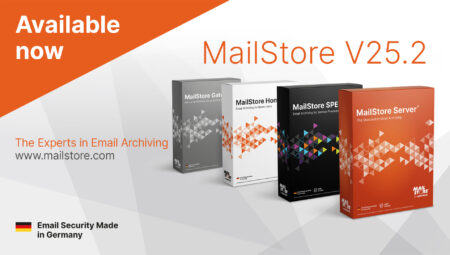Stubbing in Email Archiving: Why MailStore Refrains from Using this Technology
Many email archiving solutions use stubbing technology, yet MailStore has consciously opted to refrain from using it. Why?
What is stubbing?
The point of stubbing is to allow end users to access their emails as usual via Outlook at any time and simultaneously reduce the storage load on the email server. But what is the principle behind this practice? A stubbed email has a significantly lower storage volume than the original email. The decrease comes as a result of the email being reduced to the header information during archiving. The original emails are relocated to the archive and can be accessed via a link within the corresponding stub file. The emails require less storage space on the email server, as they have now been reduced and no longer contain information such as email content or attachments.
Why should stubbing be avoided?
If you reduce the workload of the email server and offer users familiar access to email via Outlook, it sounds great on paper. But on closer analysis, it proves problematic.
1. Statement: Use stubbing to reduce the workload of the Exchange Server
Stubbing makes it possible to reduce the data volume on the Exchange Server in the short term. However, it is the number of emails that has a greater impact on server performance, not the object size of an email. Microsoft’s white paper entitled ‘Planning for Large Mailboxes with Exchange 2007’ points out that email archiving solutions that work with stubbing and reduce the object size of emails do not gain the desired reduction in storage workload or performance improvement. “Removing the message bodies and attachments from Exchange reduces the mailbox size, but it does not significantly change the server performance for users accessing Exchange via Outlook in online mode and Outlook Web Access. Item counts are the primary performance driver for the Exchange store, and not aggregate size. For example, server performance with a folder containing 100 KB of full e-mail message items is similar to a folder containing 100 KB of stub files.“
For this reason, Microsoft does not recommend using stubbing. “When deployed, these [archiving] solutions should be configured to move the email content out of the mailbox without retaining stub files in the mailbox.”
2. Statement: Stubbing enables simple access and a familiar workflow for users
At first glance, users have the impression that nothing has changed. Their mailboxes show emails in the usual folder structure with the subject, date, and sender. However, if the user performs a search in Outlook, it is clear that the promised benefit is only partially true. This data is not available for the Outlook search, as stubbing relocates information from the content of an email or the attachment. As a result, users may have to continue their search in the archive in order to obtain usable search results, meaning the supposed advantage does not correspond to reality.
3. Statement: Stubbing is easy to implement and maintain
Setting up stubbing requires making major changes to the configuration of the Exchange Server. This is not only a time-consuming task, it is also very risky. In addition, it is necessary to check whether the stubbing components installed have been released by the manufacturer for this update before updating the Exchange Server each time. This can delay the roll-out of key security updates.
MailStore offers a live view of the archive and permanently reduces the workload of servers
It is not necessary to change the Exchange configuration in order to implement MailStore Server. MailStore Server archives all email centrally in an archive and does not use stub objects as placeholders, unlike other email archiving solutions. For example, users can also access their emails in Microsoft Outlook and search through them using an extremely fast full-text search, thanks to seamless integration. Rule-based deletion of emails after archiving permanently reduces the volumes of email on the email server and thereby successfully reduces the workload of mail servers.





